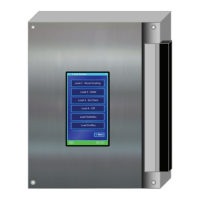Example of incompatible load combining
Primary Load 140 °F to 180 °F
Secondary Load 120 °F to 140 °F
Initial Delay: 5 mins
Off Delay: 5 mins
Retry Delay: 10 mins
Maximum Throttle %: 75 %
The secondary load temperature range of 120 °F to 140 °F is outside the range (does not overlap)
with the Primary load's supply temperature range of 140 °F to 180 °F. Load combining will be ignored,
and the loads sequentially serviced according to the system's priority rotation. "Not compatible" is
displayed on the Load Combining screen.
2.8 Setting the supply differential in heating modes
An on/off appliance, such as a boiler, must be operated with a differential to prevent short cycling.
When the supply water temperature drops below the low limit of the differential, the appliance is turned
on. The appliance continues to run until the temperature reaches the upper limit of the differential. If the
differential is set too wide, there can be large temperature swings, and if the differential is too narrow,
the appliance short cycles and operates inefficiently. To prevent short cycles and component wear-
and-tear, and to maintain boiler efficiency, you should set a differential.
Figure 11 Boiler turns on/off according to differential high and low limits
A differential is based on a boiler’s target temperature. For example, a boiler that has a target
temperature of 150°F will have a differential of 20° F (160° F being the half differential above the target
temperature and 140° F being the half differential below the target temperature). The boiler will shut off
when the supply water temperature is half the differential setting below the target temperature. It will
open when the supply water temperature is half the differential setting above the boiler target.
2.8 Setting the supply differential in heating modes

